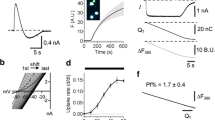Abstract
Indirect evidence has accumulated indicating a voltage dependence of the agonist-stimulated Ca2+ influx into epithelial cells. Manoeuvres expected to depolarise the membrane voltage during agonist stimulation resulted in: (1) a decrease of the sustained phase of the adenosine triphosphate (ATP, 10−5 mol/l)-induced intracellular Ca2+ transient, (2) a reduced fura-2 Mn2+-quenching rate, and (3) prevention of the refilling of the agonist-sensitive store. To quantify the change in intracellular Ca2+ as a function of membrane voltage, we measured simultaneously the intracellular Ca2+ activity ([Ca2+]i) with fura-2 and the electrical properties using the nystatin perforated patch-clamp technique in single HT29 cells. Ca2+ influx was either stimulated by ATP (10−5 mol/l) or thapsigargin (TG, 10−8 mol/l). After [Ca2+]i reached the sustained plateau phase we clamped the membrane voltage in steps of 10 mV in either direction. A stepwise depolarisation resulted in a stepwise reduction of [Ca2+]i. Similarly a stepwise hyperpolarisation resulted in a stepwise increase of [Ca2+]i (ATP: 27.5±10 nmol/l per 10 mV, n=6; TG: 19 ±7.9 nmol/l per 10 mV, n=12). The summarised data show a linear relationship between the Δ fluorescence ratio 340/380 nm change and the applied holding voltage. In unstimulated cells the same voltage-clamp protocol did not change [Ca2+]i (n=9). Under extracellular Ca2+-free conditions [Ca2+]i remained unaltered when changing the membrane voltage. These data provide direct evidence that the Ca2+ influx in epithelial cells is membrane voltage dependent. Our data indicate that small changes in membrane voltage lead to substantial changes in [Ca2+]i. This may be due either to a change of driving force for Ca2+ into the cell, or may reflect voltage-dependent regulation of the respective Ca2+ entry mechanism.
Similar content being viewed by others
References
Bahnson TD, Pandol SJ, Dionne VE (1993) Cyclic GMP modulates depletion-activated Ca2+ entry in pancreatic acinar cells. J Biol Chem 268:10 808–10 812
Clementi E, Scheer H, Zacchetti D, Fasolato C, Pozzan T, Meldolesi J (1992) Receptor-activated Ca2+ influx. J Biol Chem 267:2164–2172
Fischer H, Illek B, Negulescu PA, Clauss W, Machen TE (1992) Carbachol-activated calcium entry into HT-29 cells is regulated by both membrane potential and cell volume. Proc Natl Acad Sci USA 89:1438–1442
Gericke M, Droogmans G, Nilius B (1993) Thapsigargin discharges intracellular calcium stores and induces transmembrane currents in human endothelial cells. Pflügers Arch 422:552–557
Greger R, Kunzelmann K (1991) Simultaneous recording of the cell membrane potential and properties of the attached membrane of HT 29 colon carcinoma and CF-PAC cells. Pflügers Arch 419:209–211
Grynkiewicz G, Poenie M, Tsien RY (1985) A new generation of Ca2+ indicators with greatly improved fluorescence properties. J Biol Chem 260:3440–3450
Hallam TJ, Jacob R, Merritt JE (1988) Evidence that agonists stimulate bivalent-cation influx into human endothelial cells. Biochem J 255:179–184
Hayslett JP, Gögelein H, Kunzelmann K, Greger R (1987) Characteristics of apical chloride channels in human colon cells (HT29). Pflügers Arch 410:487–494
Horn R, Marty A (1988) Muscarinic activation of ionic currents measured by a new whole-cell recording method. J Gen Physiol 92:145–159
Hoth M, Penner R (1992) Depletion of intracellular calcium stores activates a calcium current in mast cells. Nature 355:353–356
Illek B, Fischer H, Machen TE (1992) Intracellular Ca2+ signalling is modulated by K+ channel blockers in colonic epithelial cells (HT-29/B6). Pflügers Arch 422:48–54
Jacob R (1990) Agonist-stimulated divalent cation entry into single cultured human umbilical vein endothelial cells. J Physiol (Lond) 421:55–77
Klär B, Leipziger J, Nitschke R, Greger R (1993) Ca2+ as a second messenger in CFPAC-1 cells. Cell Physiol Biochem 3:17–27
Leipziger J, Nitschke R, Greger R (1991) Transmitter-induced changes in cytosolic Ca2+ activity in HT29 cells. Cell Physiol Biochem 1:273–285
Matthews G, Neher E, Penner R (1989) Second messengeractivated calcium influx in rat peritoneal mast cells. J Physiol (Lond) 418:105–130
Matthews G, Neher E, Penner R (1989) Chloride conductance activated by external agonists and internal messengers in rat peritoneal mast cells. J Physiol (Lond) 418:131–144
Merritt JE, Rink TJ (1987) Regulation of cytosolic free calcium in fura-2-loaded parotid acinar cells. J Biol Chem 262:17 362–17 369
Morris AP, Kirk KL, Frizzell RA (1991) Simultaneous analysis of cell Ca2+ and Ca2+-stimulated chloride conductance in colonic epithelial cells (HT-29). Cell Regul 1:951–963
Murray RK, Fleischmann BK, Kotlikoff MI (1993) Receptoractivated Ca influx in human airway smooth muscle: Use of Ca imaging and perforated patch-clamp techniques. Am J Physiol 264:C 485-C 490
Nitschke R, Fröbe U, Greger R (1991) Antidiuretic hormone acts via V1 receptors on intracellular calcium in the isolated perfused rabbit cortical thick ascending limb. Pflügers Arch 417:622–632
Nitschke R, Leipziger J, Greger R (1993) Agonist induced intracellular Ca2+ transients in HT29 cells. Pflügers Arch 423:519–526
Tepikin AV, Voronina SG, Gallacher DV, Petersen OH (1992) Acetylcholine-evoked increase in the cytoplasmic Ca2+ concentration and Ca2+ extrusion measured simultaneously in single mouse pancreatic acinar cells. J Biol Chem 267:3569–3572
Tsunoda Y, Stuenkel EL, Williams JA (1990) Characterization of sustained [Ca2+]i increase in pancreatic acinar cells and its relation to amylase secretion. Am J Physiol 259:G 792- G 801
Wolff T, Leipziger J, Fischer K-G, Klär B, Nitschke R, Greger R (1993) Evidence for agonist-induced export of intracellular Ca2+ in epithelial cells. Pflügers Arch 424:423–430
Author information
Authors and Affiliations
Rights and permissions
About this article
Cite this article
Leipziger, J., Fischer, K.G. & Greger, R. Voltage-dependent Ca2+ influx in the epithelial cell line HT29: simultaneous use of intracellular Ca2+ measurements and nystatin perforated patch-clamp technique. Pflugers Arch. 426, 427–432 (1994). https://doi.org/10.1007/BF00388306
Received:
Revised:
Accepted:
Issue Date:
DOI: https://doi.org/10.1007/BF00388306




